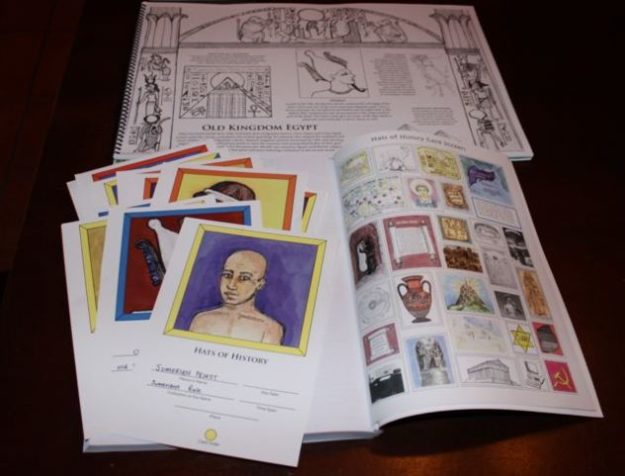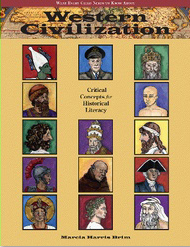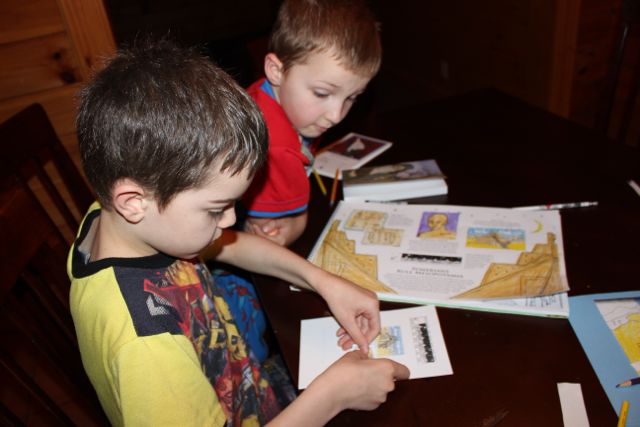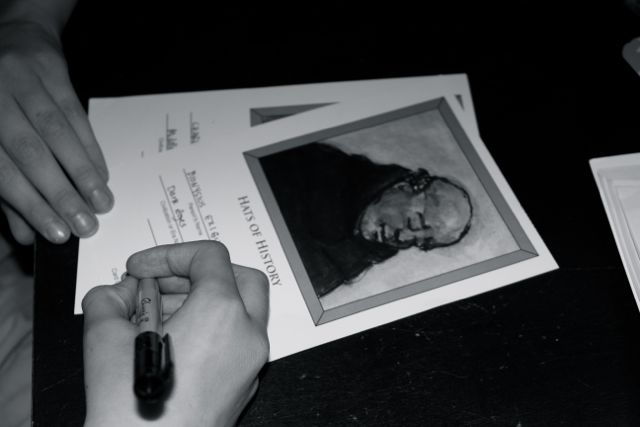It was three years ago, and… here we go again!
It’s not often that we have reviewed a new curriculum (especially one spanning 5,000 years of history) and have used it completely – in its entirety – in one summer. In fact, there’s really only one study that fully fits that description.
It’s called the Western Civilization (Calendar Quest) Study (better known in our home just as Calendar Quest) by Brimwood Press, a study that includes mapwork, timeline activities, a coloring book, stickers, and an engaging literature companion.
I was given this product in exchange for an honest review. Please know that I would not so highly recommend anything I did not feel was worth others’ time, effort, or money. I receive commissions for purchases made through links in this post. It does not cost extra to use these links but helps to support this website. To find out more, please read our disclosure policy. Thank you for supporting our family’s work here at Half-a-Hundred Acre Wood!
Now that we are officially returning to a study of world history (medieval through modern) this fall, our family is going back through Calendar Quest in its entirety! A year ago when I was thinking through curriculum choices with our children, we all decided that we would return to this study when we hit our Medieval-to-Modern cycle again because we enjoyed it so much – and because it’s a study that reviews ancient world empires. (For Classical Conversations families, this study also coincides with three cycles of memory work from the Foundations program).
Although I love the “layering” process of classical education, there aren’t many studies I truly want to repeat all over again. This one, however, offers substance that I hope to revisit multiple times. And not only will a repeat of this material help with retention and understanding, it reuses materials we have acquired in the past.
This quest takes you on on a 5,000-year journey through history (in twelve historical periods) from the Sumerians through the World Wars, from cuneiform & astrology to communism & the Cold War, and religion from ancient times to the 20th century. It can fill in many of the gaps in our knowledge of ancient history – the Sumerians, Egyptians, Babylonians, Greeks, Romans and Byzantine empire. It touches on such people as Hammurabi and Dionysius and on such topics as the Punic Wars, Patricians & Plebeians, the Nicene Creed, the Reformation…. and more. It provides connections between history [including Biblical history relevant to the calendar and Western Civilization] and geography, and it includes the advancements each culture made in mathematics, science, and writing. All of these things… the cultures and beliefs contributing to the rise of Western Civilization… and how they all tie into the formation of the calendar we use today. The abstract made concrete for my children – and for me.

The student/teacher manual includes timeline cards, stickers, and a simple review game for reviewing the material.
The tools for our quest: A combined open-and-go Student/Teacher Manual called What Every Child Needs to Know about Western Civilization, a historical fiction & literature companion Calendar Quest, comprehension questions (Kenny Kwiz), and an 11″x17″ coloring book called Color the Western World. (Visit the links to read product descriptions and download free sample pages).
Intended to be completed in approximately one month, this history curriculum is only 16 lessons long. But there exists great depth within each lesson and continuity between each lesson. And even though it can be completed in one month, it can also be completed over a 16-week period, which is how long it took us to complete it previously at one lesson per week. In fact, we are planning to take our sweet time and use the entire school year next year to go back through this study. Check out our Western Civilization Loop Schedule!
This study uses literature as the “hook” or “attention grabber.” In fact, I started reading the book Calendar Quest before the other materials arrived (even though I wasn’t supposed to). When I told the boys that we needed to stop reading to await the arrival of the other materials, they made me fully aware of their disappointment.
Each lesson starts with a literature activity from the time-travel-themed book, Calendar Quest, (with reading comprehension questions in the Western Civilization guide if you are still learning the skill of narration). {For months after we read the chapter on Babylon, David pretended to be Hammurabi shouting, “Dates! Dates! I need more dates!” (Thankfully, he was referring to the edible kind of dates.)}
Students then label and color-code a map as part of a geography activity related to the history (from What Every Child Needs to Know about Western Civilization).
Each lesson has a History-in-a-Nutshell activity in which the students memorize and place a person into their correct date, civilization, and geographic region. Students begin their quest by placing the cards into the order they *think* they should go. This is great even for those who have previously memorized history sentences and/or a timeline because they can verify their knowledge and/or understanding of the event/person. After the first lesson, they progress through the timeline and see how far off their original timeline card placement was.
As we progress through the timeline, the student writes information onto the timeline card such as key date, time span, and place.
While the parent reads each lesson from the What Every Child Needs to Know about Western Civilization book (there are actually even short summaries offered in the appendix in case you have children with short attention spans!),
the student can color in the figures within a huge 11″x17″ coloring book called Color the Western World (which includes history summaries for each civilization that made contributions to western civilization as it exists today; this coloring book is a great history study just by itself! Click here for a sample of Color the Western World),
…and then the student can place the history stickers that match their coloring page onto the back of the timeline card.
The final lesson in this book includes a review game activity to verify the students’ retention of which culture did what and how those contributions tie into the overall history of Western Civilization.
This study helped me (a person whose natural academic strengths do not include history and geography) to connect our memory work chronologically while gaining an understanding of how Western Civilization came to exist as it is today. Although our oldest son (a person whose natural academic strengths DO include history and geography) and I engaged in some enlightening “dialectic discussions” as we made many connections to facts we’ve memorized in the past, the other two (at the time, age 4 and 7) just enjoyed coloring maps and pictures, sticking stickers on the cards, and reciting memory work as certain people and places came up in our reading. The emphasis on memory work, review, and coloring/stickers made it an engaging program for them as well!
This curriculum does not shy away from the tough topics which have also shaped Western Civilization, such as:
- The Scopes Trial
- Darwin’s Origin of Species
- Genetic Engineering
- The history of the church and the good it has done
- The history of the church and the bad it has done in the name of Christ: the Inquisition, Anti-Semitism, Persecution…
We live in a world of skepticism. Why are there so many who have turned from religion? What has contributed to the rejection of Christianity? How can we use this knowledge to better equip ourselves against this skepticism? These are open-ended questions that families may discuss as they see fit, as this curriculum does not focus on answering these questions directly. As with so many of Brimwood’s products, it provides the historical context of the events, and parents can use history as a springboard for Biblical or doctrinal discussions.
For younger children, some of these tougher topics can be adjusted as appropriate, but we are ultimately equipping our children to think logically about such issues; we’re equipping them to be world changers in a world that has issues! Without God and His unfailing love, we end up with atrocities like the Holocaust and… well, any of the heartache that comes from believing life is an experience of complete futility.
——————————-
If you are in Classical Conversations…
I wanted to share this with those who are looking for a concise history program to use over the summer or over the course of next school year. It’s a study that can help you connect the history you’ve learned in Cycle 1, 2 and 3 of the Foundations program.
Cycle 1
It references the geography (and timeline) from multiple weeks of Cycle 1.
It references topics related to Weeks 1, 2, 5, 6, 11, and 12 of Cycle 1. Actually, it touches on everything we studied in Cycle 1 except the Far East, South America, and Mesoamerica.
Cycle 2
It references the geography (and timeline) from multiple weeks of Cycle 2.
It references history topics related to Weeks 1, 2, 3, 5, 6, 7, 9, 10, 11, 14-17, 21 and 22 of Cycle 2. [All of which are contained within Lessons 12-16 of the Western Civilization Study.]
Cycle 3
The final 3 lessons in this study reference history topics related to United States History (Cycle 3, Weeks 2, 4, 5, 17, 18, 19, 24).
——————————-
If you are looking for a concise history program – one that will help connect ancient history to the middle ages to modern America – or if you are looking for a broad overview of world history before delving into more involved history studies, this program is a great one to consider! Visit Brimwood Press for more details on each of these products, to download free samples, or to purchase the Western Civilization Study set.
Free Download Samples:
Sample Lesson of Hats and History and the History stickers.
Sample Additional Activities
Sample Maps for each lesson
Sample Color the Western World
You may want to check out these other fantastic products available from Brimwood Press:
Writing Historical Fiction Using Your Family Tree
Introduction to Worldview
Understanding Centuries with a Toothpick Timeline
Conversations from the Garden
Christian Theology and Ancient Polytheism

















